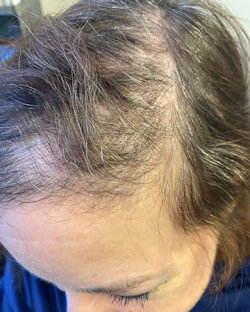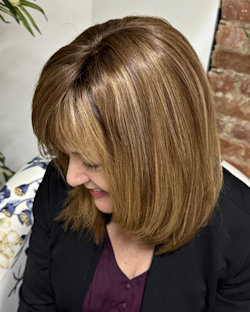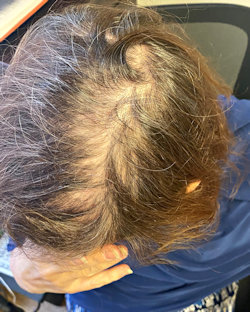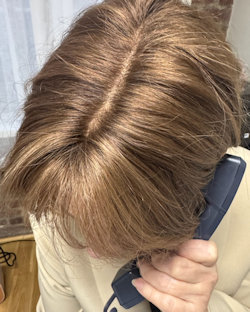Telogen Effluvium (Hair Shedding) in New York City
What is Telogen Effluvium?
Telogen effluvium is a very common type of hair loss that occurs when the hair has entered the resting phase, and hair begins to shed.
Excessive shedding can be caused when there is any type of shock to the system (this 'shock' can be either physical, physiological or emotional).
The way to best understand TE is to start by understanding the growth cycle of your hair. There are three general phases of the hair cycle.
The Anagen (growth phase), Catagen (transitional phase) and Telogen (resting phase)
Then it cycles; Anagen, then Catagen, then Telogen phase; Anagen, Catagen, Telogen, etc.
On average, throughout the hair cycle, scalp hair will grow at approximately ½ inch per month and each hair follicle can go through a complete cycle between 10 and 20 times in an average hair life cycle.
The growth phase (Anagen) can last several years (average is three years) This is when your hair is actively growing.
Next it will enter the Catagen Phase. This is when growth stops. It is a relatively short phase which may only be 2-3 weeks, the middle of the follicle pulls together, and this causes a bulb to form at the bottom of hair follicle. The follicle starts to shrink and detach. While the hair stays in place, it can become thinner in appearance.
After Catagen, the hair enters the resting phase called the Telogen Phase. This can last approximately 4 months.
During the Telogen phase hair is shed so that new hair can begin to take its place. When you enter this phase the bulb at the base of the dermal papilla, and the hair shaft is either pulled out (which is normal when combing or brushing your hair) or it can be pushed out (by a new shaft that has already started to grow).
You might see clubbed hairs falling out during this phase, and some may have a small white bulb at the bottom of the hair that has fallen out. This does not necessarily mean that the root has come out, but that the hair behind it has pushed the short 'clubbed' hairs out of the way. Depending on how long the hair behind it has been growing, you may see a marked number of 'short hairs' coming in.
In our New York salon, we see a lot of clients who are concerned that they are losing their hair excessively. However, we remind them that it is completely normal to lose about 100 hairs per day. You might see them in the sink or the brush or comb, or even on your pillow. But this loss or shedding is due to the normal growth cycle of your hair.
When Telogen become excessive
If you are experiencing active or excessive Telogen Effluvium (TE), you may lose 300 hairs or more per day.
As we mentioned, TE occurs when an outside stressor causes the hairs that would normally continue in the growth phase, to prematurely be forced into the resting phase. And this shock can cause extreme hair shedding and loss.
The "shock or stressor" to the system that can cause Telogen Effluvium can be a signal that there is a disruption in the system caused by disease, stress, or medications.
Depending on the cause, this phase can be acute or chronic and there can be as much as 60-70% of 'growth hairs' forced into the resting phase at once and this can cause chronic telogen effluvium.
Most often acute telogen effluvium resolves on its own. But chronic telogen effluvium can last between 6 months to indefinitely. While chronic TE is not likely to cause permanent baldness, it is possible to lose your hair in handfuls during the early stages.
What caused my TE?
There are many different causes of telogen effluvium in women: hormonal changes, high fevers, severe infections, underactive and overactive thyroid conditions, childbirth, stress, injury, surgery, illness, disease, inadequate diet or crash dieting, improper nutrition or inadequate protein, as well as a variety of medications. All can be causes of telogen effluvium.
You may not notice the hair loss for week to months after the incident that triggered the body to start telogen hair loss, and the shedding can continue until the cause is corrected or eliminated. Once the 'shock to the system' is eliminated it may take six to eight months more for the hair to go back to its normal hair growth cycle.
Chronic telogen effluvium can also affect women between 30 and 60 years of age with no sudden shock or cause. This type of chronic TE can fluctuate over years and since some cases of TE can affect the entire scalp. To the casual observer, a woman who previously had very thick hair in her teens and twenties will still look like they have a lot of hair, but to the woman experiencing chronic TE, there is a noticeable difference, with no obvious cause being apparent.
In most cases of telogen effluvium, it will resolve on its own. When it is caused by the normal hair growth beneath it, pushing out the follicle in favor of a new, it can be a sign of hair regrowth. Clubbed or shortened hairs are a sign that telogen effluvium is taking place but this may be part of the normal growth cycle after a stressor has ended.
When experiencing chronic or excessive telogen effluvium, it is important to determine the cause. Once the cause has been determined and addressed the hair may return on its own to some extent.
For those whose TE does not resolve naturally, the Intralace System® can help.
Our solution for Telogen Effluvium - the Intralace System®
Our Intralace System® is designed specifically to allow your hair to continue to grow through and beneath the patented mesh system.
You need only 1 inch of hair around the perimeter to be able to secure this integrated system. Even if you are experiencing chronic telogen effluvium minimal hair is needed as each hair will be gently introduce through the Intralace System® mesh between the existing hair and the scalp.
This technique enables women to participate in normal everyday activities and since each system is custom-made system we can adjust it to allow for natural hair loss as well as extensive TE.
Because your Intralace System® allows your hair to continue the normal growth cycle or growing, shopping, shedding, etc it will need to maintained by our trained hair artists approximately every 6 to 8 weeks. At these appointments, whether it is in our New York studio or our salon in Beverly Hills, the growth will be noted at your appointments and your system adjusted as needed.
At 6 months we will take the entire system off, wash and photograph your scalp and wash the system before realigning it. This gives us further opportunity to view your scalp and hair growth along the way.
Come and see us
Location
Located at Park Avenue and East 28th Street, the salon is easily reached from Brooklyn, the Bronx, or Queens via the 6 train or from Westchester or Connecticut via Metro North Railroad and clients are welcome to call for a free consultation.
We understand how busy and hectic your lives can be and these initial consultations can also be done via Zoom or Facetime. They are an opportunity for us to get to know your goals and see how we might help you accomplish them.
Contact
Please contact us by phone at (212) 359-1641 or via the Contact page email form to take the first step towards the hair you love.
Lucinda Ellery is not a medical facility and we do not make diagnoses nor medical recommendations in any way. The Site cannot and does not contain medical and or health advice. The medical/health information is provided for general information and educational purposes. Accordingly, before taking any actions based on such information, we encourage you to consult with the appropriate professional. The Use or reliance on any information contained on the site is solely at your own risk and discretion.




